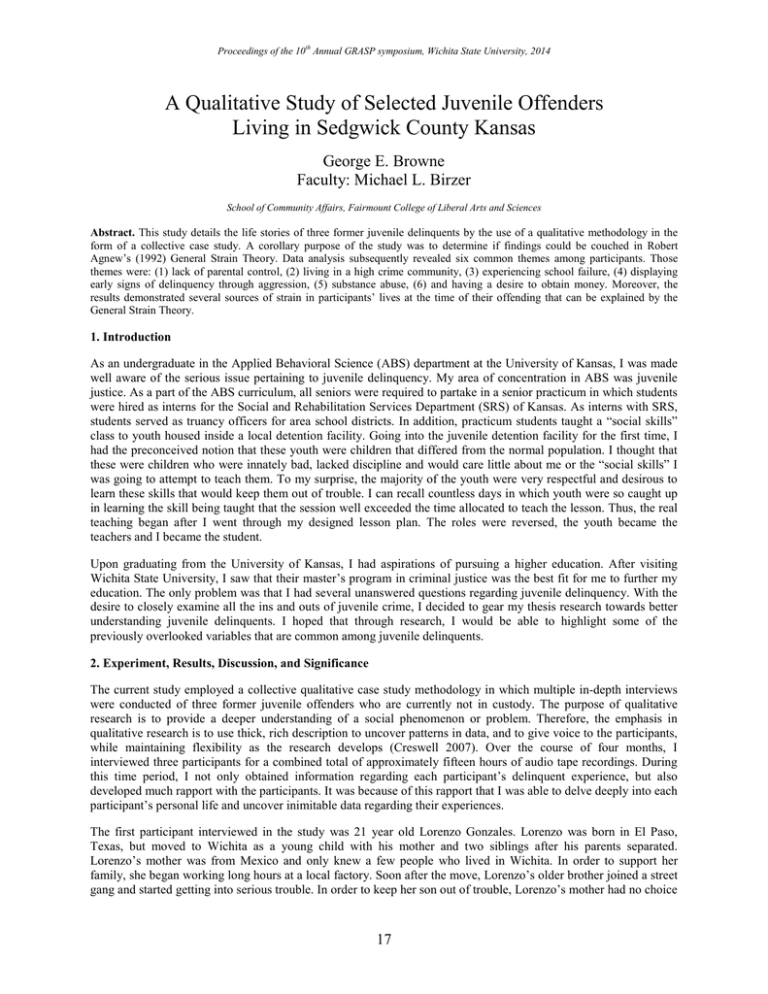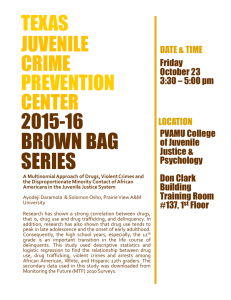A Qualitative Study of Selected Juvenile Offenders George E. Browne
advertisement

Proceedings of the 10th Annual GRASP symposium, Wichita State University, 2014 A Qualitative Study of Selected Juvenile Offenders Living in Sedgwick County Kansas George E. Browne Faculty: Michael L. Birzer School of Community Affairs, Fairmount College of Liberal Arts and Sciences Abstract. This study details the life stories of three former juvenile delinquents by the use of a qualitative methodology in the form of a collective case study. A corollary purpose of the study was to determine if findings could be couched in Robert Agnew’s (1992) General Strain Theory. Data analysis subsequently revealed six common themes among participants. Those themes were: (1) lack of parental control, (2) living in a high crime community, (3) experiencing school failure, (4) displaying early signs of delinquency through aggression, (5) substance abuse, (6) and having a desire to obtain money. Moreover, the results demonstrated several sources of strain in participants’ lives at the time of their offending that can be explained by the General Strain Theory. 1. Introduction As an undergraduate in the Applied Behavioral Science (ABS) department at the University of Kansas, I was made well aware of the serious issue pertaining to juvenile delinquency. My area of concentration in ABS was juvenile justice. As a part of the ABS curriculum, all seniors were required to partake in a senior practicum in which students were hired as interns for the Social and Rehabilitation Services Department (SRS) of Kansas. As interns with SRS, students served as truancy officers for area school districts. In addition, practicum students taught a “social skills” class to youth housed inside a local detention facility. Going into the juvenile detention facility for the first time, I had the preconceived notion that these youth were children that differed from the normal population. I thought that these were children who were innately bad, lacked discipline and would care little about me or the “social skills” I was going to attempt to teach them. To my surprise, the majority of the youth were very respectful and desirous to learn these skills that would keep them out of trouble. I can recall countless days in which youth were so caught up in learning the skill being taught that the session well exceeded the time allocated to teach the lesson. Thus, the real teaching began after I went through my designed lesson plan. The roles were reversed, the youth became the teachers and I became the student. Upon graduating from the University of Kansas, I had aspirations of pursuing a higher education. After visiting Wichita State University, I saw that their master’s program in criminal justice was the best fit for me to further my education. The only problem was that I had several unanswered questions regarding juvenile delinquency. With the desire to closely examine all the ins and outs of juvenile crime, I decided to gear my thesis research towards better understanding juvenile delinquents. I hoped that through research, I would be able to highlight some of the previously overlooked variables that are common among juvenile delinquents. 2. Experiment, Results, Discussion, and Significance The current study employed a collective qualitative case study methodology in which multiple in-depth interviews were conducted of three former juvenile offenders who are currently not in custody. The purpose of qualitative research is to provide a deeper understanding of a social phenomenon or problem. Therefore, the emphasis in qualitative research is to use thick, rich description to uncover patterns in data, and to give voice to the participants, while maintaining flexibility as the research develops (Creswell 2007). Over the course of four months, I interviewed three participants for a combined total of approximately fifteen hours of audio tape recordings. During this time period, I not only obtained information regarding each participant’s delinquent experience, but also developed much rapport with the participants. It was because of this rapport that I was able to delve deeply into each participant’s personal life and uncover inimitable data regarding their experiences. The first participant interviewed in the study was 21 year old Lorenzo Gonzales. Lorenzo was born in El Paso, Texas, but moved to Wichita as a young child with his mother and two siblings after his parents separated. Lorenzo’s mother was from Mexico and only knew a few people who lived in Wichita. In order to support her family, she began working long hours at a local factory. Soon after the move, Lorenzo’s older brother joined a street gang and started getting into serious trouble. In order to keep her son out of trouble, Lorenzo’s mother had no choice 17 Proceedings of the 10th Annual GRASP symposium, Wichita State University, 2014 but to send him to Mexico to live with his grandmother. Following the move of his brother, Lorenzo joined a street gang and picked up where his brother left off. Lorenzo was a full pledged gang member by the 6th grade. His delinquent experience was plagued with arrest for offenses such as drug possession, drug distribution, and battery. He did not desist from his criminal behavior until the age of 18, when he began a serious dating relationship. The second participant in the study was Michael Rodriquez. Michael was a 20 year old Hispanic male who has lived in Wichita, Kansas his whole life. Michael grew up in a household comprised of his mother and four other siblings. Although Michael’s mother had five mouths to feed every night, she had a good paying job and the family was able to live comfortably. However, things soon changed after Michael’s mother was laid off from her job and the family was forced to live off of much less. A few months after losing her job, Michael’s oldest brother was arrested for murder. The arrest had an immense impact on Michael because he was very close to his brother. In the year following his brother’s arrest, Michael began engaging in high rates of criminal activity. His juvenile experience was filled with auto burglaries, fights, and even being shot at. Michael’s main outlet to getting into trouble was boxing. Michael began boxing in the 6th grade and displayed early signs of talent. Today Michael is a professional boxer and prioritizes raising his children and his boxing career over getting into trouble. The last participant interviewed in the study was Richard Rodriquez. Richard was a 23 year old Hispanic male, who grew up in Wichita. Richard is the older brother of Michael Rodriquez. At age 16, Richard was arrested for murder following a home invasion. Although Richard did not shoot the homeowner, he was a participant in the home invasion was subsequently arrested and charged with murder. After accepting a plea agreement to a juvenile charge of murder, he was sentenced to seven years of incarceration in a juvenile facility. During the first few years of his incarceration, Richard was frustrated with the outcome of his case. He was frequently reprimanded for his behavior and found himself getting into trouble daily. Nonetheless, things suddenly changed after Richard had a conversation with a guard at the detention facility. The guard told Richard to “do the time” and not “let the time do him.” From then on out, Richard changed his attitude and used the remainder of his time behind bars to better his life. He obtained his high school diploma, learned various employable trades, and was released early on good behavior. The results of the current study flushed out six collective themes that were salient among participants’ juvenile delinquent experiences. Those themes were: (1) lack of parental control, (2) living in a high crime community, (3) experiencing school failure, (4) displaying early signs of delinquency through aggression, (5) substance abuse, (6) and having a desire to obtain money. Many of these themes match various “sources of strains” identified in Robert Agnew’s (1992) General Strain Theory. Thus, the General Strain Theory served as the underpinning criminological theory. 3. Conclusions Utilizing results from the current study, the researcher suggest juvenile delinquency may be combated by the use of mentorship programs, career building workshops, college campus visits, and teachers should attend specialized training on how to deal with troubled youth in their classes. The final results indicate that juvenile offenders are not innately bad people; rather, it is more that they often lack opportunities to prosper. Instead of being met with opportunities to excel, youth are often presented with avenues to commit crime. In order to combat juvenile delinquency, all members of the community must do their part. Even if only a small handful of youth are deterred from becoming juvenile offenders, it will all be well worth the effort. 4. References [1] Agnew, R. (1992). Foundation for a general strain theory of crime and delinquency. Criminology, 30, 47−87. [2] Creswell, J.W. (2007). Qualitative inquiry and research design: Choosing among five approaches, (2nd ed.). Thousand Oaks: Sage. 18

